In menswear, one of the most consistently confusing topics is the correct sleeve length of shirts, jackets, and suits. How long should each be, and how do you effectively combine them?
Having the correct sleeve length of your shirts and jackets is a subtle hallmark of a menswear expert; it reflects attention to detail and a dedication to getting the look just right. It’s also not an area that you can get away with NOT paying attention to; sloppy sleeve length can make you look like a boy who outgrew or borrowed his clothes.
Unfortunately, sleeve length seems to be a gray area in which anyone can claim to be an expert, no matter how much or how little they know about dressing well. Often, rules are cited and absolute measurements are provided, though most forget that the look of the sleeve-cuff conjunction is not only about the length. It is also about the right fit and the harmony of the interaction between the two garments.
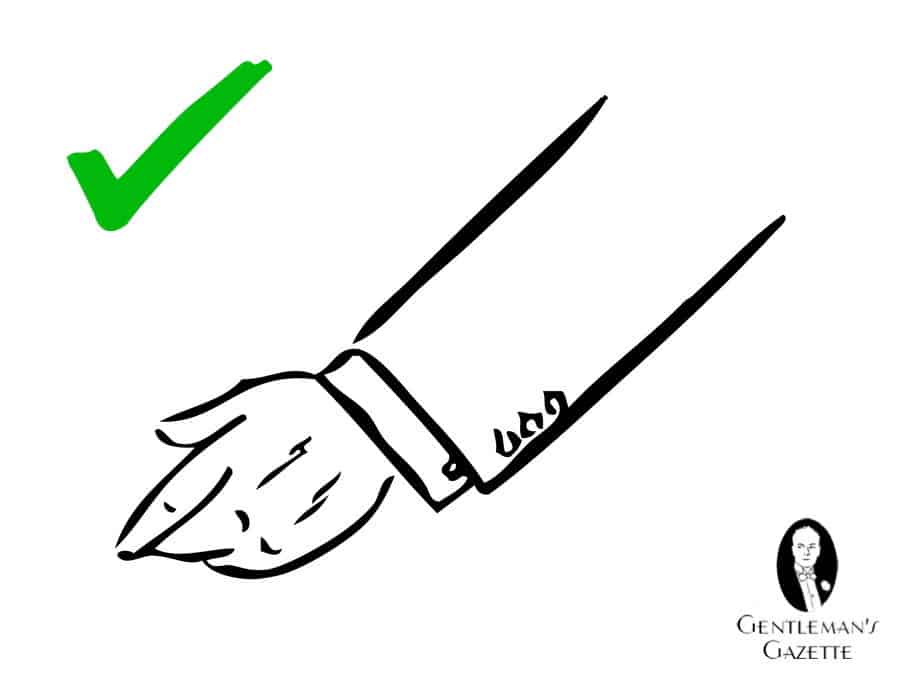
To make sure your sleeves are all the right length for you, we’ll start by taking a deep dive into the length of shirt sleeves, which starts with evaluating the features of the shirt to find the right ones before you buy. Then, we will move on to jackets and how to best pair them with shirt sleeves for the best possible combination.
What is the Correct Shirt Sleeve Length?
The answer is that your shirt cuff should fall to the base of the thumb, but that requires many considerations to get it right. Basically every feature of a dress shirt – the cut, the armhole size, the cuff button placement, the width of the cuff – will affect the length of the shirt sleeve. Let’s review how each element affects the sleeve length of a dress shirt.
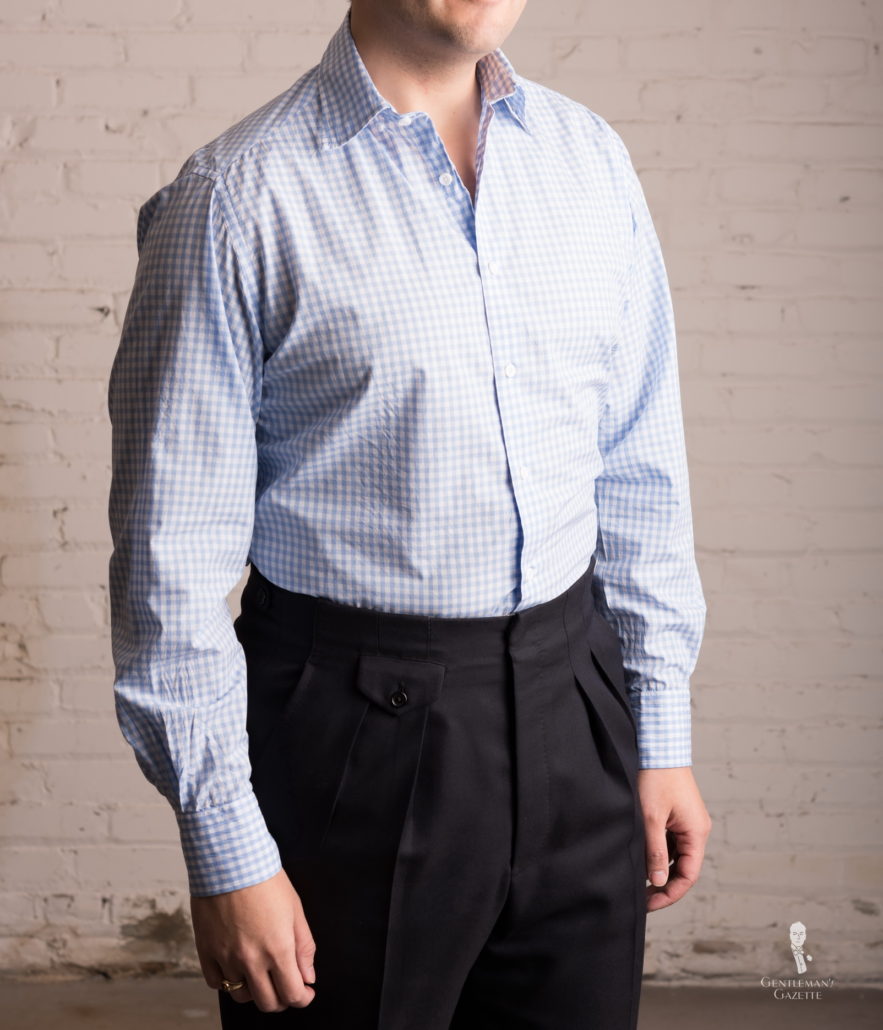
Sleeve Length for French Cuff Shirts
Ideally, a French cuff shirt should reach to the root of the thumb at all times, even when you move. If your cuff moves when you lift your arms, you have a problem with the armhole or the shirt length. Your shirt armholes could be too big, or they could be bigger than your sleeve, thus pulling the shirt sleeve up when you move. To avoid that, opt for a shirt armhole that is big enough to make you comfortable but small enough to keep the shirt cuff at the right length.
Here are the considerations to make regarding french cuff or double cuff shirts with regards to achieving proper sleeve length.
French Cuff Shirts Should Have a Horseshoe Shape Cuff
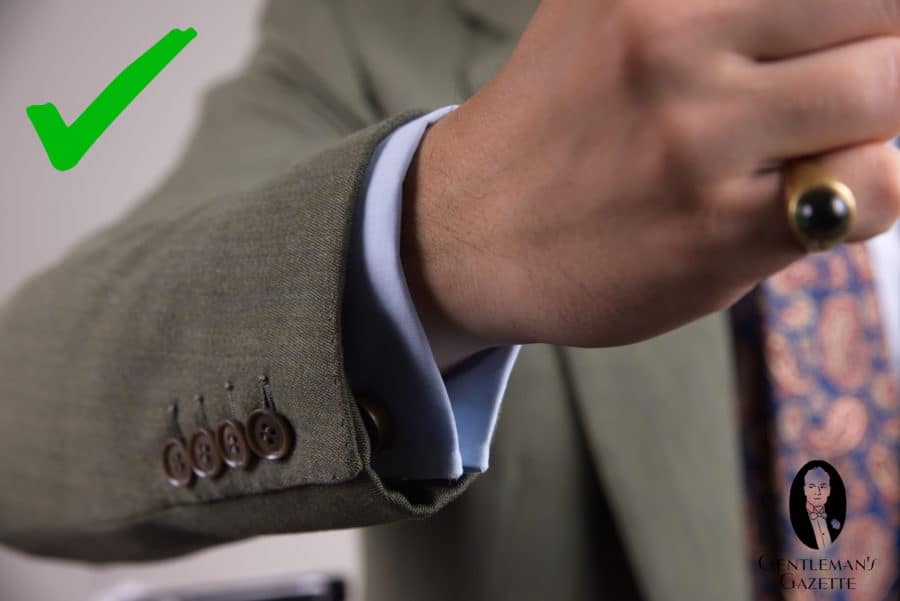
A French cuff or double cuff shirt cuffs should neither fit too tightly nor too loose. It should sit snugly so that the cuff forms a horseshoe shape around the wrist, without straining or sliding down over your thumb. This way, the cuff will not move up or down, even if you have a bit of an extra length in your sleeves.
The French Cuff Buttonhole Should Be Positioned Closely to the Edge of the Cuff
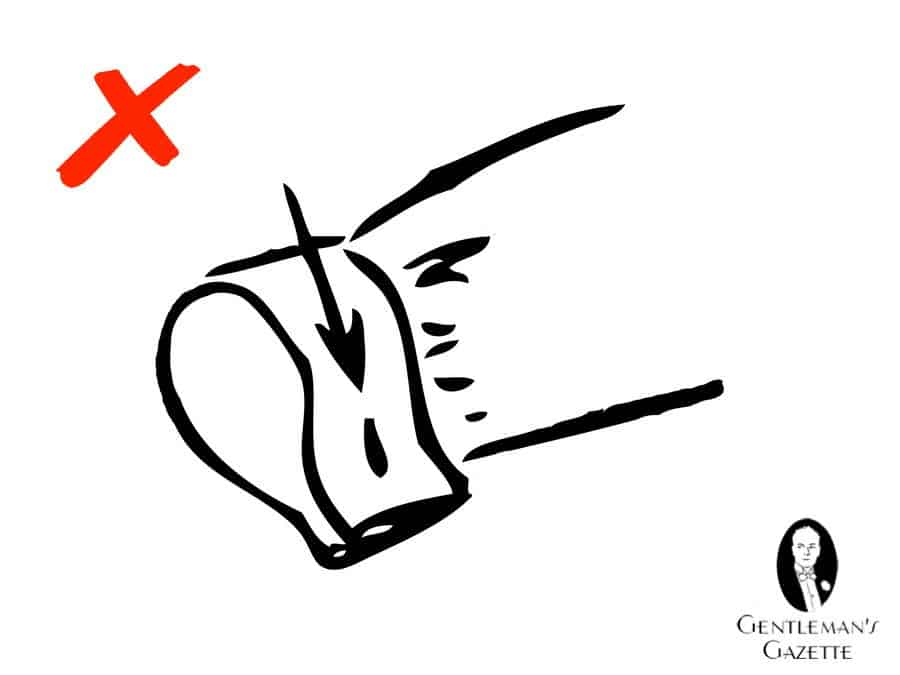
The buttonhole should be located in the middle of the cuff and positioned rather closely to the edge because otherwise it is too tight and the excess folded fabric creates an odd “wing” on your cuff. In Britain, sometimes the buttonhole is located at the front of the cuff to display more of your cufflinks. In continental Europe, and especially in Germany, this feature was usually only seen on evening shirts or morning dress rather than on general day shirts. What you prefer is simply a matter of taste.
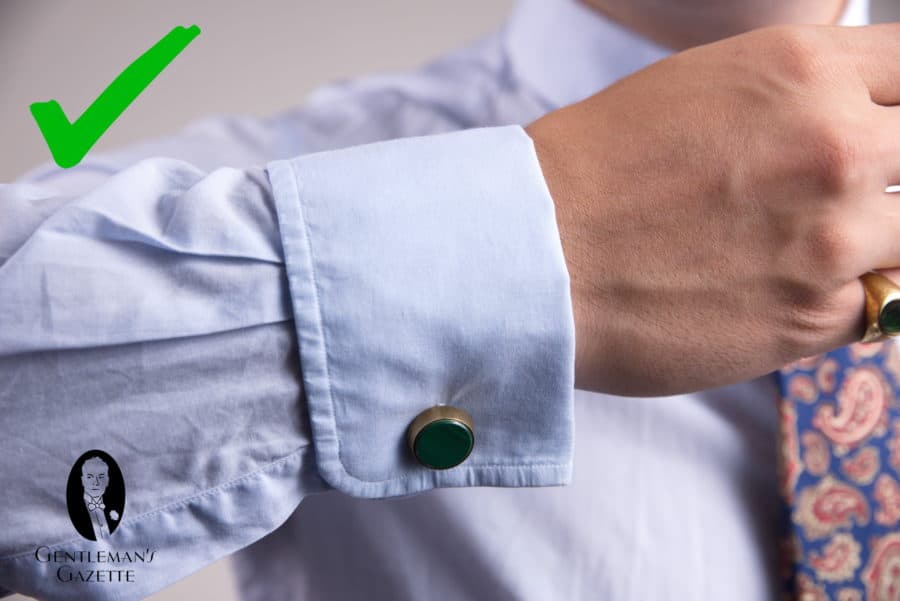
Of course, if you are a watch wearer, make sure to leave enough space beneath your cuff for the biggest wrist watch you would wear with that particular shirt. Sizing one cuff slightly larger is a feature that can only be accomplished with custom shirts. Even then, there are sometimes huge differences in the size of watches, which means that some watches can only be paired with some of your shirts.
Shirt Cuff Must Not Be Too Wide Otherwise It Slides Down
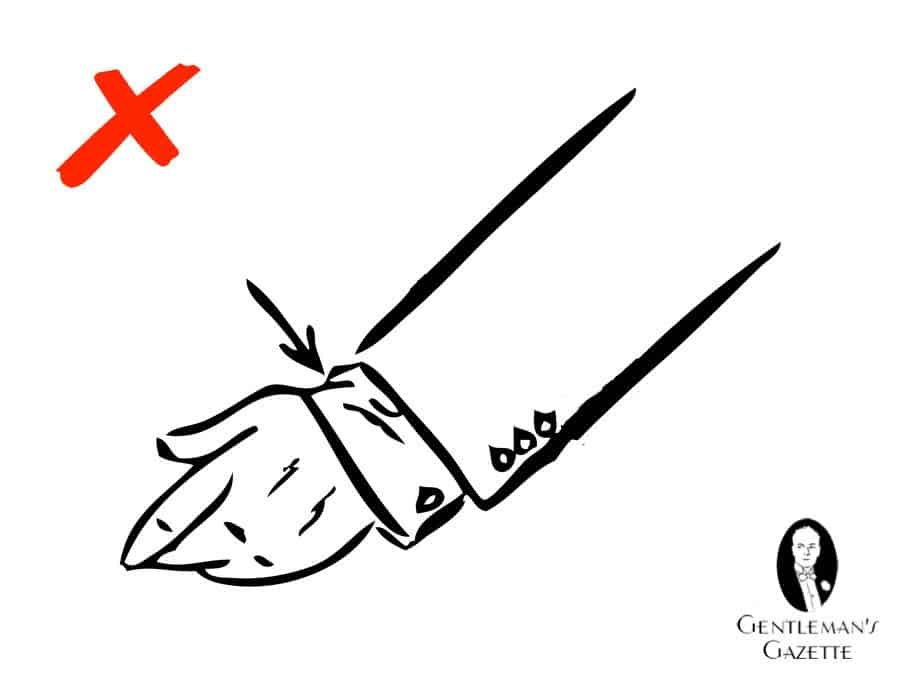
If your shirt cuff is so wide that you can slide your hand through with the cufflinks in it, your cuffs will slide down on to your hand. Not only does that look like you got a shirt from your older brother, but it also results in unsightly wrinkles.
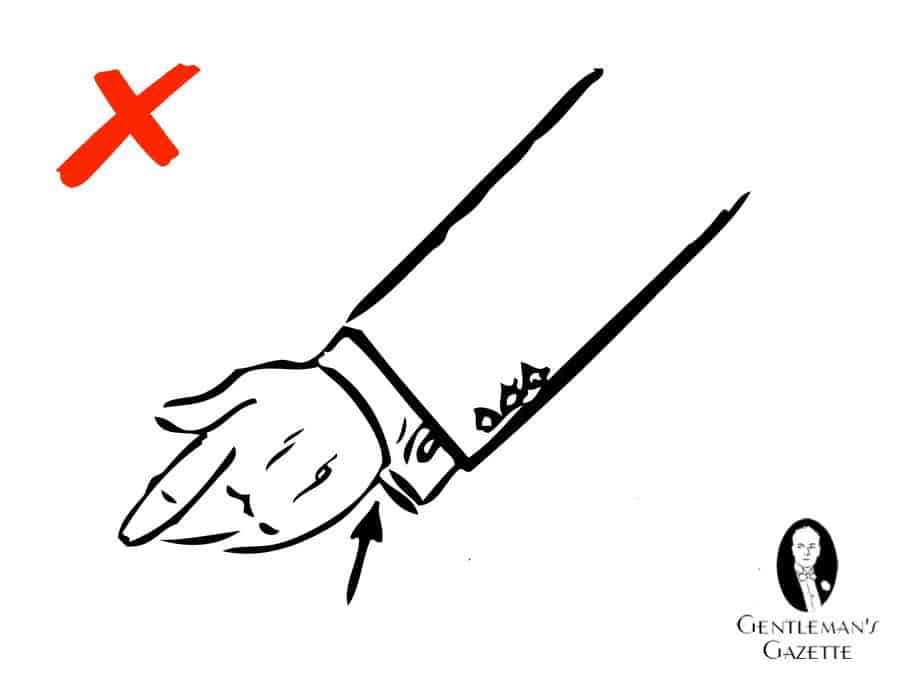
French Cuffs Should Not Be too Narrow Otherwise it Throws Off the Proportions
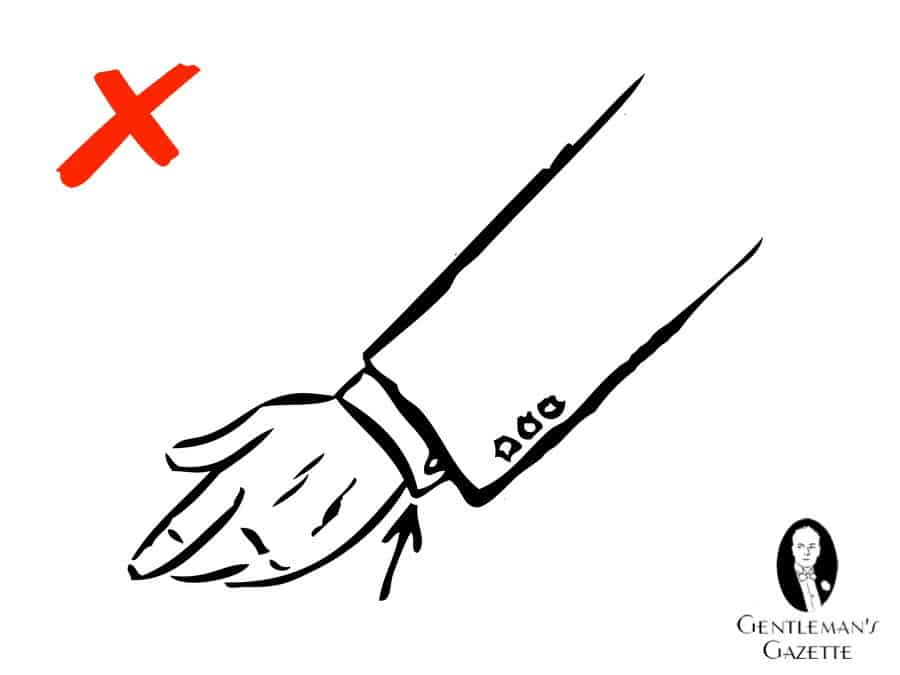
If your shirt cuff is too tight and narrow, it may throw off the proportion to the shirt sleeve by making your jacket sleeve appear to be oversized (even if it isn’t).
Sleeve Length for Button or Barrel Cuff Shirts
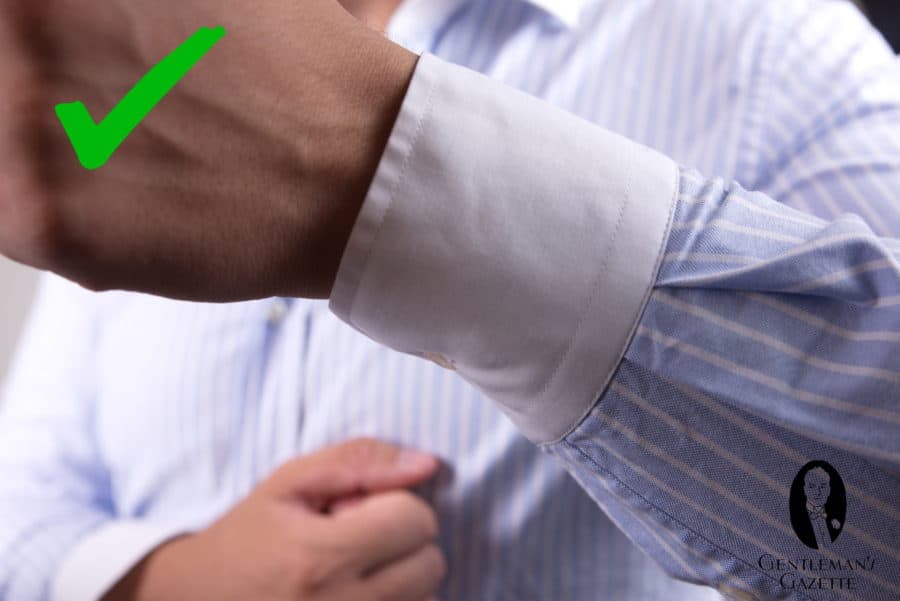
Button cuffs are narrower than French cuffs because the fabric wraps around the wrist, overlapping the buttoning point. No jewelry is required to close the cuffs, which are already outfitted with buttons. Ideally, a barrel cuff should fit closely to your wrist; most men underestimate what “closely” means and overly wide barrel cuffs abound. If your barrel cuff is properly fitted, there should only be room for 1-2 fingers between your skin and the cuff. This close fit helps hold them in place, while maintaining the trimmer profile that is important for a barrel cuff.
Overly wide shirt cuffs will not hug your wrist, and they will slide up and down your arm, causing them to hang to far over your hand or get bunched up under your jacket sleeve.
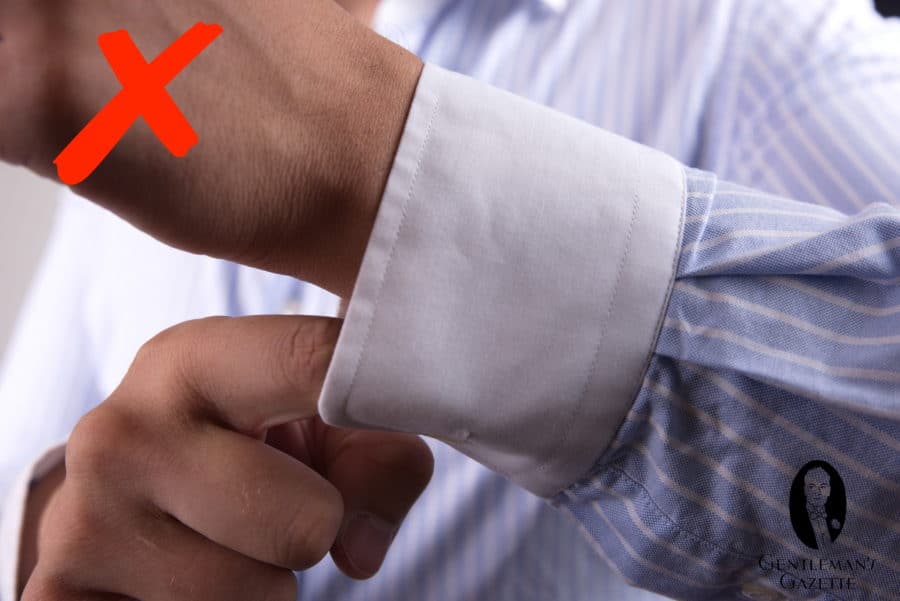
If you wear a wristwatch, you need a little bit of extra space, but the fit should still be trim. In fact, if you order custom, MTM or bespoke dress shirts, they should be able to widen the watch-wearing cuff slightly while keeping the non-watch wearing side snug.
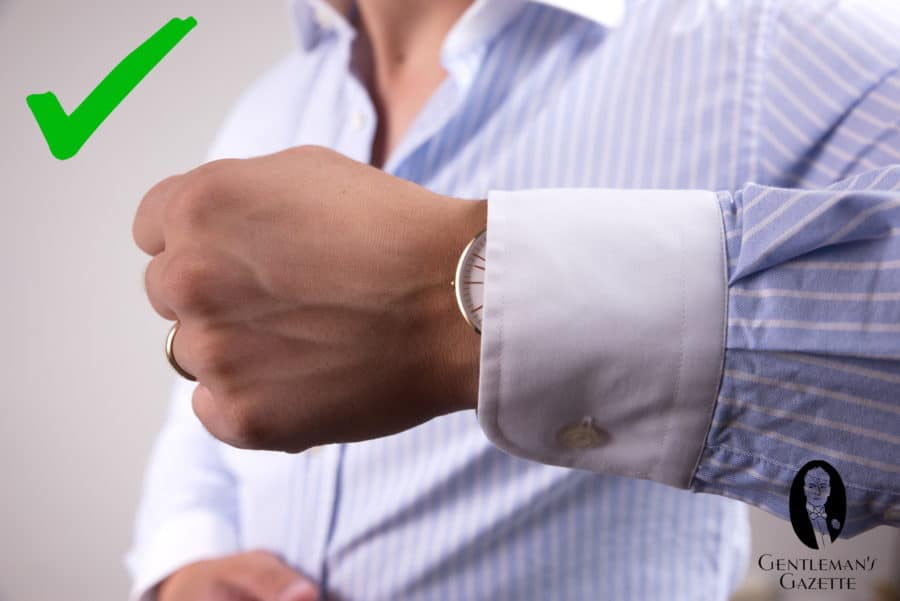
The Proper Jacket and Suit Sleeve Length
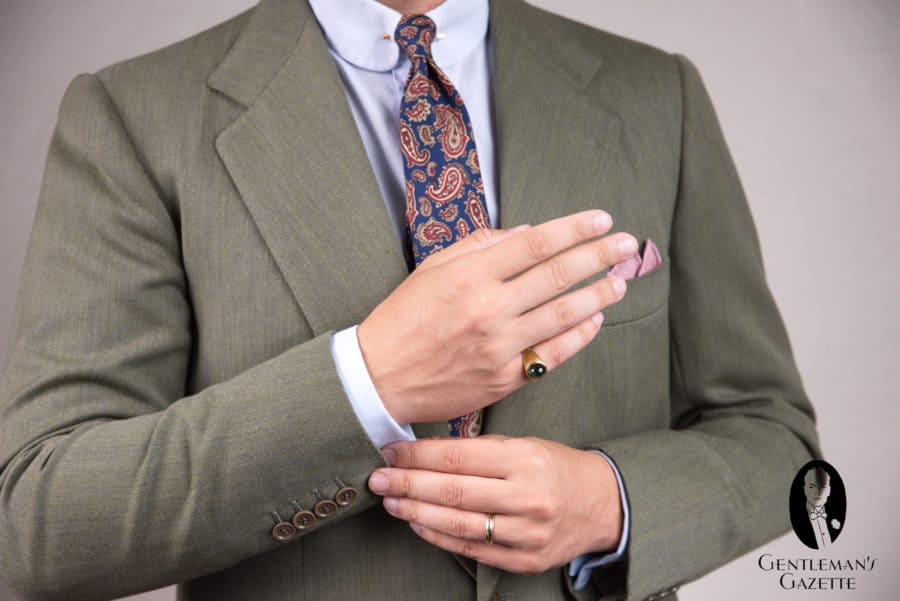
Once you’ve purchased barrel and french cuffshirts that have the proper fit, you can move on to combining them with jackets, where once again balancing the proportions is key to achieving a good look. Because the balance of both the shirt and jacket sleeve can only be perfect if they work together, you have to pay attention to both when you buy a garment. For the best results, we suggest to get the fit of the shirt cuff right first, and then select or tailor the jacket sleeve width accordingly.
Jacket Sleeve Width
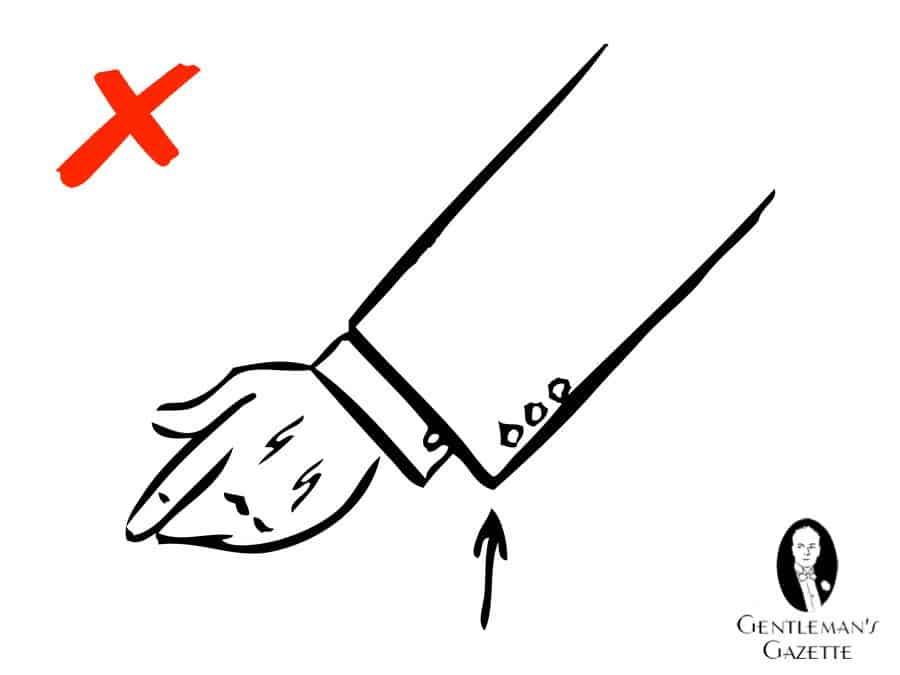
Jacket sleeve width varies from jacket to jacket, so you’ll need to choose the cuff that harmonizes with each jacket. Consequently, the ideal jacket sleeve width alters with the chosen cuff! Traditionally, button cuffs became the standard for sportscoats and casual garments, and French cuffs were worn with more formal suits.
Today, men can wear anything they want and consequently, those rules are optional to you. However, to get the right look, narrower jacket sleeves should be paired with a barrel cuff while wider jacket sleeves should be paired with a french cuff. Older jackets sometimes have a very wide sleeve hem that even shows the sleeve lining. That is simply too big and it makes your hands appear small and disproportional. If there is too much or too little space between the cuff and the sleeve, you’ve likely made the wrong choice.
To Show Cuff or Not to Show Cuff?
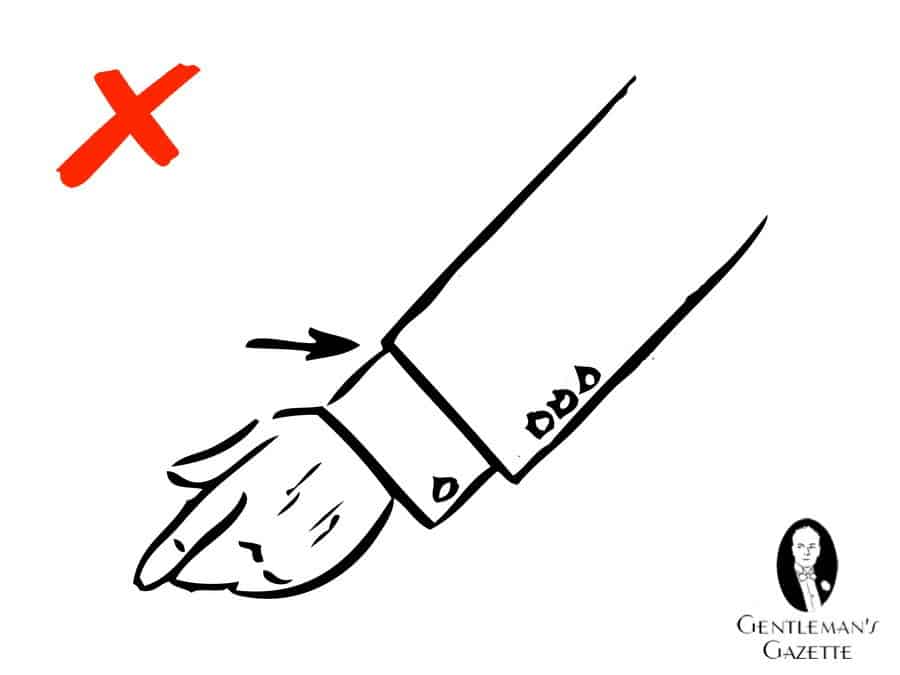
Many menswear guides claim that the proper amount of cuff to show falls between between 1/2″ (1.25 cm) to 1″ (2.5cm). Most guides, us included, agree that anything more than 1.25″ (4cm) is too much cuff to show; it makes the junction of your two sleeves look like you haven’t considered how they will go together. Here is a sampling of how much cuff menswear experts suggest you show under your jacket sleeve:
- Alan Flusser – 1 cm (2/5″)
- Bernhard Roetzel – at least 1 cm (2/5″) of the cuff should visible but more can be ok as well
- Bert Bacharach claimed it should be just 1/4″ (0.64cm) in 1953
- Baron von Eelking suggests to show 2cm (4/5″) of cuff if they are soft, and 1cm (2/5″) for stiff cuffs you’d wear with white tie or black tie
- Sydney Barney explains in Clothes and The Man that sleeve length is a matter of taste and that you and your tailor should follow the current trend
- Nicholas Storey notes in the History of Men’s Fashion that some British bespoke tailors often prefer not to show any shirt cuff at all
- C. Northcote Parkinson wrote in the publication Parkinson’s Law that Americans show cuff and the British do not
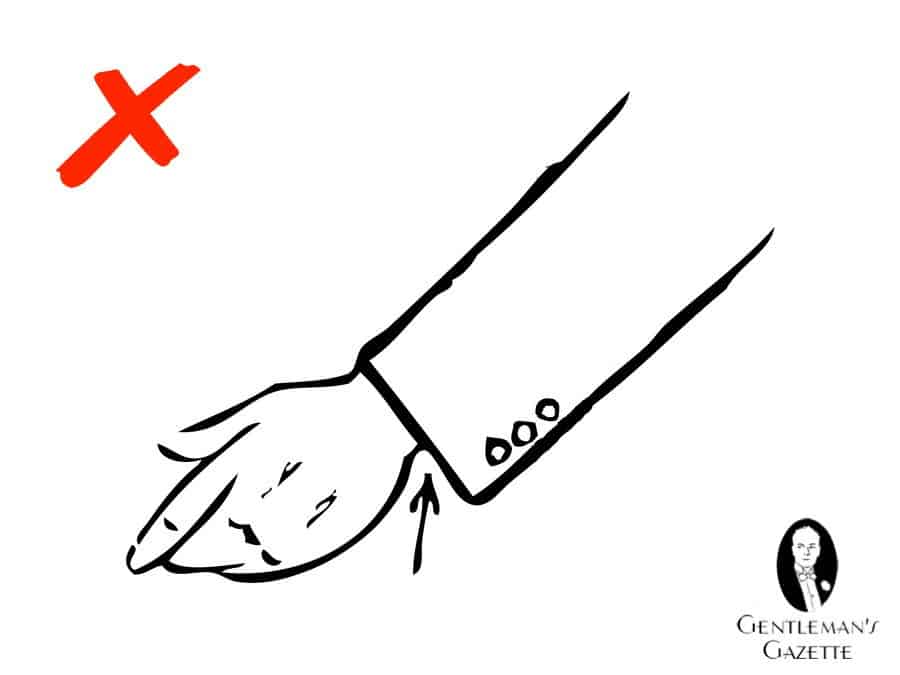
In fact, many photographs and fashion illustrations from the US and continental Europe display men showing some cuff but it varies from picture to picture. As you can see, throughout menswear history, many men wore their coat sleeves short enough to show some cuff, but there were also other dapper gentlemen who chose to do the opposite.
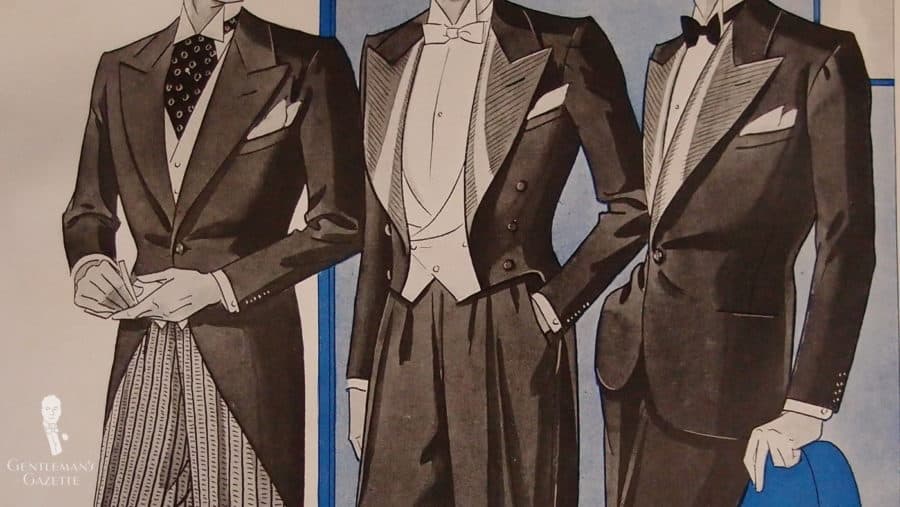
As such, any “rule” about the matter should not be regarded as an absolute, but much rather as a helpful guideline for men as they decide what to wear.
Matching the Amount of Cuff to the Shirt Collar
At the Gentleman’s Gazette, we prefer to show about 0.5″ & 1.25cm (or a hint more) because we believe it looks best when the amount of shirt cuff visible matches the amount of shirt collar that is visible in the back of the neck. Again it is all about proportions and creating harmony in an outfit. Please watch the video for more details.
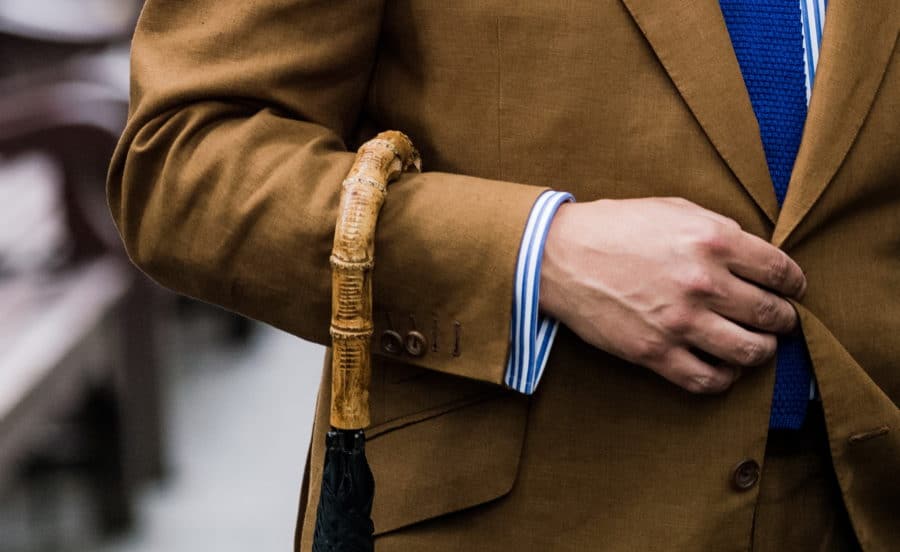
What Sleeve Length is Right For You?
As you can see, there is more to a sleeve than just the proper length. At the end of the day, a lot boils down to taste. If you focus on proportion and harmony, you will always be well dressed. If you show cuff, make sure that it is not too short and focus on the fit as outlined above.
If you enjoyed this guide, you might also like our guide 30 Style Mistakes & How To Avoid Them, our ebook Gentlemen of The Golden Age and 25 Tips to Dress More Elegantly.
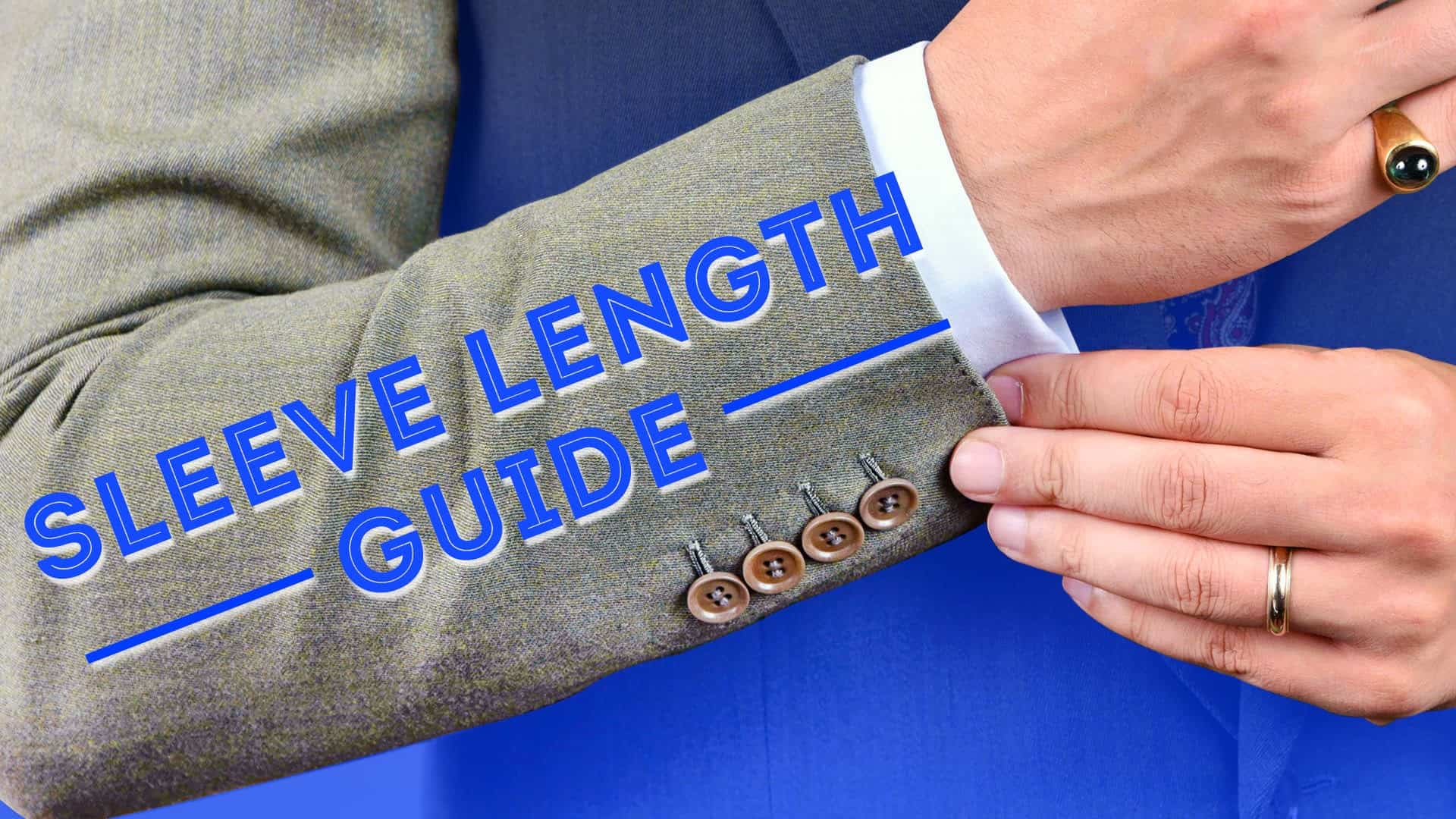

Infinitely interesting and the all the angles and correlations well rounded off.
Great post, good job on the clarifying pictures.
By the way, could you give your opinion on the right suit jacket lenght? Nowadays you see many relatively short jackets, whereas they used to be longer. I tend to like the longer jackets more than the (too) short jackets you see often nowadays.
Many men wear their jackets too short for 1930’s or 1950’s standards but I can write about that in the future.Thanks for your interest.
Again I’ve learned somthing new. Before all the illustrations are well chosen. Such articles are the very reason why this fine gazette stands out in it’s kind.
Thank you and keep on the good work.
Thank you all for your kind words.
It’s a good overview, but again it just serves to make miserable all those who don’t have their clothes made for them. Who will now be worrying that they’ll need to have the sleeves of half of their jackets narrowed to look “correct”. And that they can’t pair certain shirts with certain jackets, which I believe to be utter nonsense.
What puzzles me is that yu start out by declaring it a matter of taste., then conclude with a tutorial on the “proper method”!
Hans, thanks for your comment. This guide was based on historic facts not the current ready to wear industry and I am sorry to make you feel miserable but it was not my intention, especially since I pointed out, that it is fine not to show any cuff.
If you read the text again, you will notice that I used “taste” in reference to Mr. Barney. If you do not show any cuff, things are rather simple, aren’t they. However, if you show cuff I outlined how it used to be done properly.
It seems to me like people often want things to be easy and simple but they are not always that. For example, most people would be probably able to just eat with a fork nevertheless, you will find many pieces of silverware in fine restaurants and in Victorian times, it was not unusual to see over a hundred pieces of silver ware on the table. I am not making a judgment as to what is better but I show how complex things were. That’s why correct is in “correct”. Each to his own but if you care about clothes and their history, here you learn how it was done.
It doesn’t make me miserable personally. I have my own sleeves to the lengths I require because I make them myself.
The real point is about showing people alleged “correct” methods for showing shirt cuff (or whatever); I don’t believe there is one. And I also believe that most of the advice of this sort is invented from perusing films, photos and drawings that don’t show a completely realistic picture of how people have dressed in the past.
I’m not saying people didn’t show shirt cuff, but that it has never been a rule or a standard or a widespread common practice. The blogs and forums of today are reinventing the sartorial past with their own rules tacked on. This is why we see people stubbornly insisting that all waistcoats must have the bottom button undone, or that the four-in-hand knot is the ‘only knot you’ll need’, with a photo of some star like Cary Grant wheeled out to “prove” it.
I agree that you gave all the options, but underneath is also the tacit implication that showing cuff is somehow the more elegant standard. And also you gave only an opinion about how French cuffs are to be worn. Personally I like them somewhat tighter than you seem to, but I don’t think I’m wrong. Having loose French cuffs, in my opinion, looks sloppy. Taste indeed.
Dear Hans,
This information was all based on different trade publications, menswear magazines and books from the 1910″s – 1960’s and don’t just represent my fantasy. As said before, each to his own but it would be foolish to assume that there were no rules in regards to dress code in society.
Does that mean, everybody adhered to it back then? Absolutely not, however the fashionable men did. Did it make sense? Not really, but that’s the case with many things in life. As outlined by the different authors, there were different rules at different times in different countries. This shows there is no absolute truth or correct way of doing something. As always, I try to show the different historic options without dictating one particular option. However, people always ask for the proper length and the ultimate shirt, guide, rule etc. and here they can find an article that explains things more detailed, giving everybody the option to wear what they like and the opportunity to learn how men’s did it in the past.
So the whole lot was meaningless?
Dear Sir,
I have two sets of books that I use as a reference and guide when drafting and cutting a pattern. One set pre-war the other post-war when British tailoring was at it’s zenith. Sleeve length like any garment is as much about style as it is about taste. We can advise or suggest that a certain cut would suite a client better, but the art of bespoke is that the garment is custom made to the clients requirements whether or not it is deemed poor style or bad taste.
Kinds regards
Cameron
Mr. Schneider, I always enjoy your videos and in fact enjoy just watching and listening to you. HOWEVER I do need to suggest you pay a little more attention to detail. In the video and in examples #3 and #9 (possibly others) the pressing of the cuff and shirt sleeve was terrible. I am not a perfectionist but you need to be as many look to you for perfection! Do you have someone critic your newsletters/videos/pictures? Please make sure you come across in ALL aspects of your advice as the true expert I believe you are. My entire family of many men are subscribers to your newsletter. Thank you so much for being such a gentleman.
Dear Sir, thank you for this post, I have one concern with this subject: in my experience the cuff shown with a suit or sports jacket will be different if you leave your arms down along your body or bend your forearm (like for shaking hands), so what is the appropriate position to measure the amount of cuff shown? I have seen a video in which a tailor (Caraceni maybe?) advises to bend the arm half way with the thumb up to measure the cuff. In your illustration of the “perfect shirt cuff to sleeve cuff ratio” (gentleman with an umbrella) I feel like if this man was to let his arm down one would hardly see any cuff. What is your recommendation on this point? It is important because when you get your coat altered you do so with your arm down, and if you measure the 1/2 inch of cuff in that position you may end up with much more (too much?) cuff shown when you bend your arm. Thank you for sharing your experience.
How did you lose all the readers who made nice comments over four years ago?
I expect the unpleasant ones have put them off. Sadly a lot of people find the anonymity of the web to be a useful mask behind which to put others down in order to bolster their own inadequate self esteem. This discourages friendly people from commenting and you have a race to the bottom in terms of warmth and good manners. It’s one of the curses of the age. Of course jealousy can play a role as well. Here’s someone doing something well and successfully, and rather than be inspired and seek to do the same some people would rather sneer. Sad.
Great article with very useful illustrations.
I wear my jacket sleeves too long – at least according to the “rules” most menswear books and blogs quote.
To those in doubt I would say read the rules but wear what you think looks best on you.
Thank you for a very comprehensive article about one of the more overlooked aspect of a suit. Regarding barrel and French cuffs, if you’re planning to wear your suit with both, then how do you pull off the sleeve width correctly?
I am a new member of this community and this is the first article I saw. I must say, very informative and interesting. Keep up the good work.
Back in the eighties, when I bought my only Brooks Brothers suit, the tailor asked me how much cuff I wanted to show. This was the first time I was asked. I asked how much is the right amount? The reply was words to the effect of “If you are Continental, then one half inch, if you are American then one quarter inch.
Being a newbie wearing a suit , I found the video interesting and educational. Indeed, it’s a matter of taste and comfort which is of most importance in my opinion. People will critic which is right or wrong. But it will always boil down to the choice of the wearer. What is most comfortable to wear and at the same time looking good to one’s taste and preference. Thank you.
Thank you for sharing Crisostomo!
Something I’ve been finding troublesome lately is that my OTR shirts with unfused cuffs) (e.g. Oxford shirts tend to push themselves out a bit and wrap around my hand, rather than sitting at the base of my thumb! Is this just the nature of unfused cuffs or is it a result of them still not being right enough?
In addition, if your cuff is bigger to accomodate a watch, does the watch keep it in place so it doesn’t slide?
Thank you for all the videos. The information is very useful for me as a woman working in a men’s clothing shop.
I point out the importance of the shoulder seam sitting at the correct point, different collar and cuff styles, and I have them try on a shorter pant to show how much nicer 1 break in the pant leg is than 3 breaks. So many people have no idea of the basics. Or that shirts come in different sleeve lengths and suits in various cuts.
In the end, it’s how they feel in the clothing and if they like what they see in the mirror.
By sharing the information you present, I believe, I’m helping make the world better dressed, one man at a time. The gentlemen who subscribe are way ahead of my customers.